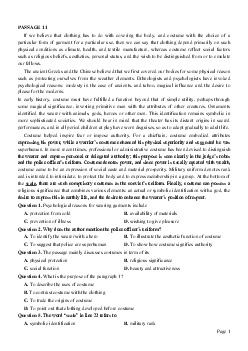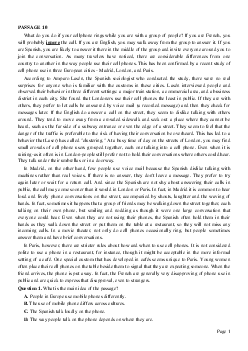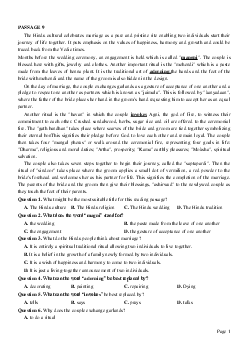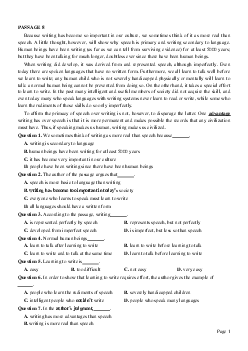


Preview text:
PASSAGE 22 PANDEMIC DISEASES
Diseases are a natural part of life on earth. If there were no diseases, the population would grow too
quickly, and there would not be enough food or other resources, so in a way, diseases are natural ways of
keeping the Earth in balance. But sometimes they spread very quickly and kill large numbers of people.
For example, in 1918, an outbreak of the flu spread across the world, killing over 25 million people in
only six months. Such terrible outbreaks of a disease are called pandemics.
Pandemics happen when a disease changes in a way that our bodies are not prepared to fight. In 1918, a
new type of flu virus appeared. Our bodies had no way to fight this new flu virus, and so it spread very
quickly and killed large numbers of people. While there have been many different pandemic diseases
throughout history, all of them have a new thing in common. First, all pandemic diseases spread from one
person to another very easily.
Second, while they may kill many people, they generally do not kill people very quickly. A good example
of this would be the Marburg virus. The Marburg virus is an extremely infectious disease. In addition, it is
deadly. About 70 -80% of all people who get the Marburg virus died from the disease. However, the
Marburg virus has not become a pandemic because most people die within three days of getting the
disease. This means that the virus does not have enough time to spread a large number of people. The flu
virus of 1918, on the other hand, generally took about a week to ten days to kill its victims, so it had more time to spread.
While we may never be able to completely stop pandemics, we can make them less common. Doctors
carefully monitor new diseases that they fear could become pandemics. For example, in 2002, and 2003,
doctors carefully watched SARS. Their health warnings may have prevented SARS from becoming a pandemic.
Question 1. According to paragraph 1, how are diseases a natural part of life on Earth?
A. They prevent pandemics
B. They help control the population
C. They led the world grow quickly
D. They kill too many people
Question 2. Based on the information in the passage the term “pandemics” can be explained as
A. diseases with no cure
B. a deadly kind of flu
C. diseases that spread quickly and kill large numbers of people
D. new disease like SARS or the Marburg virus
Question 3. According to the passage, what causes pandemics?
A. Changes in a disease that body cannot fight
B. Careless doctors who do not watch the spread of disease
C. Population growth that the world cannot support
D. The failure to make new medicines
Question 4. According to the passage, all of the following are true of the 1918 flu pandemic EXCEPT that
A. it involved a new kind of flu virus
B. it killed over 25 million people
C. it was the last pandemic in history
D. it took a little over a week to kill its victims Page 1
Question 5. The word “it” in the passage refers to A. disease B. flu virus C. pandemics D. bodies
Question 6. Which of the following is mentioned as a common feature of all pandemic diseases?
A. They spread from people to people very quickly
B. It kill many people very quickly
C. They do not kill people very quickly
D. They kill all the victims
Question 7. According to paragraph 3, why hasn’t Marburg virus become a pandemic?
A. It is not a deadly disease
B. It does not spread from person to person easily
C. Doctors have prevented it from becoming a pandemic
D. It kills people too quickly
Question 8. The word ‘monitor’ in the passage is closest in meaning to A. fight B. prevent C. watch D. avoid
Question 9. The author mentions SARS in order to
A. give an example of a highly dangerous disease
B. suggest that SARS will never become a pandemic
C. give an example of the successful prevention of a pandemic
D. suggest that there may be a new pandemic soon.
Question 10. This passage is mainly about
A. how to prevent pandemic diseases B. pandemic diseases
C. pandemic diseases throughout history
D. why pandemics happen ĐÁP ÁN 1-B 2-C 3-A 4-C 5-B 6-C 7-D 8-C 9-C 10-B
LỜI GIẢI CHI TIẾT Question 1:
Theo đoạn 1, bệnh dịch đã trở thành một phần của tự nhiên vì:
“If there were no diseases, the population would grow too quickly, and there would not be enough food or
other resources, so in a way, diseases are natural ways of keeping the Earth in balance” => Nếu như
không có bênh, dân số sẽ tăng lên nhanh chóng, không đủ thức ăn và các nguồn tài nguyên, nên bệnh dịch
là một biện pháp tự nhiên để giữ cân bằng trái đất. Question 2:
Dựa vào thông tin trong đoạn văn, bệnh dịch có thể được giải thích là gì?
“they spread very quickly and kill large numbers of people” => bệnh dịch thì tất nhiên phải là bệnh rồi, và
căn bệnh này lan rất nhanh và làm nhiều người chết. Question 3: Page 2
Theo bài khóa, nguyên nhân nào dẫn đến bệnh dịch?
“Pandemics happen when a disease changes in a way that our bodies are not prepared to fight. “ = Bệnh
dịch xảy ra khi một căn bệnh thay đổi theo cách mà cơ thể chúng ta không được chuẩn bị để kháng lại. Question 4:
Theo bài khóa, tất cả các câu dưới đây đúng trừ:
Đáp án C sai vì trong bài đọc không có thông tin liên quan đến điều đó. Các đáp án còn lại đúng vì:
+ Đáp án A: “In 1918, a new type of flu virus appeared”
+ Đáp án B: “in 1918, an outbreak of the flu spread across the world, killing over 25 million people in only six months.”
+Đáp án D : “The flu virus of 1918, on the other hand, generally took about a week to ten days to kill its
victims, so it had more time to spread.” Question 5:
Từ “it” chỉ đến cái gì?
“Our bodies had no way to fight this new flu virus, and so it spread very quickly and killed large numbers
of people.” = Cơ thể chúng ta không có cách kháng lại loại virut cúm mới này, nên “it - loại vi rut cúm
này” lan rất nhanh và làm nhiều người thiệt mạng. Question 6:
Câu nào dưới đây được coi là một đặc điểm chung của tất cả các bệnh dịch?
“Second, while they may kill many people, they generally do not kill people very quickly” = Bệnh dịch
khiến nhiều người chết nhưng nhìn chung lại không khiến người ta chết nhanh. Question 7:
Theo đoạn 3, tại sao Marburg lại không được coi là bệnh dịch?
“the Marburg virus has not become a pandemic because most people die within three days of getting the
disease” => Marburg không phải là bệnh dịch vì phần lớn mọi người tử vong sau 3 ngày nhiễm bệnh –
nhanh- trong khi đó đặc điểm của bệnh dịch là không khiến người bệnh chết nhanh. Question 8:
Monito = watch (v): trông chừng, theo dõi, quan sát
Các bác sĩ cẩn thân theo dõi các bệnh mới vì họ sợ bệnh dịch sẽ xảy ra. Question 9:
Tác giả đề cập đến SARS nhằm mục đích gì?
“Doctors carefully monitor new diseases that they fear could become pandemics. For example, in 2002,
and 2003, doctors carefully watched SARS. Their health warnings may have prevented SARS from
becoming a pandemic” => Các bác sĩ đã theo dõi các bệnh mới rất cẩn thận phòng bệnh dịch xảy ra, ví dụ
là SARS và họ đã thành công trong việc ngăn chặn SARS trở thành bênh dịch => Đưa ra 1 ví dụ về việc
ngăn chặn dịch bệnh thành công. Question 10:
Bài văn chủ yếu nói về vấn đề gì?
+ Bài văn xoay quanh chủ đề “bệnh dịch” – nhan đề
+ Tác giả chủ yếu nói đến: bệnh dịch là gì, khi nào xảy ra bệnh dịch, các ví dụ về đại dịch trong lịch sử. Page 3




